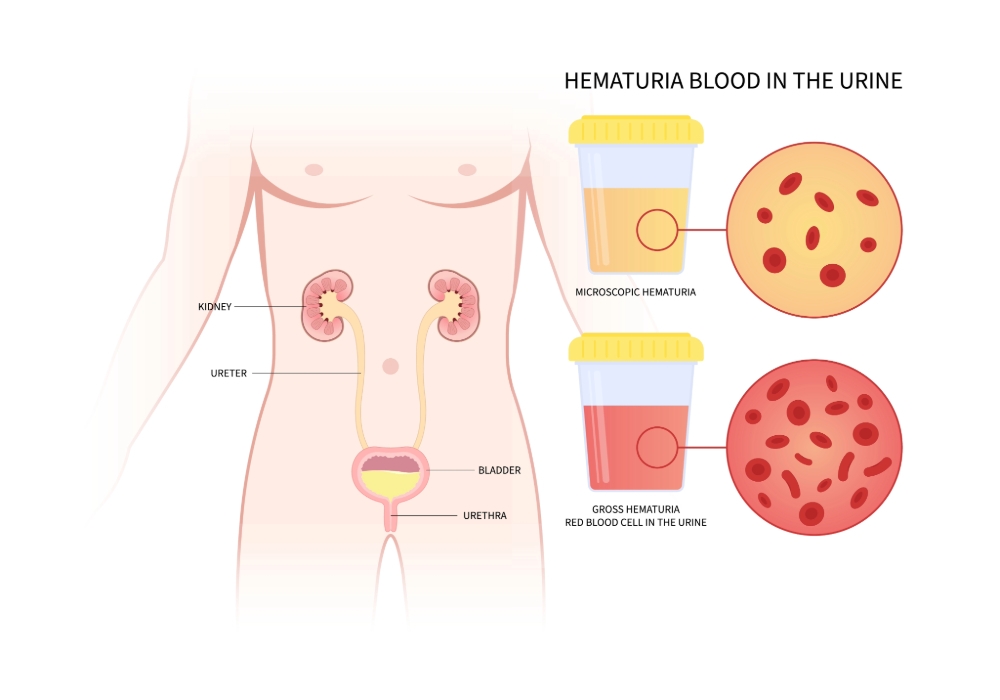Most people with microscopic hematuria do not have symptoms. Most commonly, it is discovered incidentally during a routine examination. People with gross hematuria have urine that is pink, red, or cola/tea colored due to the presence of red blood cells. Gross hematuria may be painless or may be associated with pain or discomfort in the side, back, or abdomen, or while urinating.
Hematuria - Risks & Causes
Hematuria may be caused by either benign or potentionally more serious conditions. It's important to get an evaluation done by your doctor to rule out potentially serious conditions.
Factors that increase risk of developing hematuria:
- Inflammatory conditions of the kidney, ureter, or bladder
- Prostatitis, an infectious or inflammatory condition of the prostate in men
- An enlarged prostate, which typically occurs with hematuria, whether gross or microscopic, can be caused by benign or more serious conditions. The source of the bleeding is more commonly discovered with gross hematuria.
Common benign conditions causing hematuria:
- Menstruation
- Vigorous exercise such as long-distance running
- Sexual activity
- Viral illness
- Trauma
- Urinary tract infection (UTI)
- Certain medications, including aspirin and other pain relievers, blood thinners, and antibiotics
Potential serious causes of hematuria:
- Cancer of the kidney or bladder
- Urinary stone disease, including stones in the kidney, ureter or bladder
- Polycystic kidney disease, a disorder characterized by multiple benign cysts in the kidney
- Blood clotting disorders, such as hemophilia or sickle cell disease
Hematuria - Symptoms & Evaluation
An evaluation is reccomended if microscopic hematuria is identified with greater than three red blood cells on your urine sample. If there are less than three red blood cells seen on your sample, the urine should be tested again after 48 hours for the presence of red blood cells. If two of three urine samples show too many red blood cells when viewed with a microscope, an evaluation is also reccomended.
Evaluation
- Urinalysis is used to detect abnormalities other than the presence of red blood cells. The presence of white blood cells and/or bacteria signals a urinary tract infection. Red blood cells that are misshapen or clumped together may indicate underlying kidney disease. Large amounts of protein in the urine, called proteinuria, may also indicate kidney disease.
- Urine cytology is when a urine sample is evaluated for the presence of cancer cells. If present, they may indicate a tumor lining the urinary tract in the kidney, ureter, or bladder, a more serious causes of hematuria.
- Kidney imaging tests is an important component of the evaluation of hematuria.
- KUB X-ray - A kidney, ureter, and bladder (KUB) X-ray may be performed to assess the abdominal area for causes of kidney pain, or to assess the organs and structures of the urinary system. A KUB X-ray may be the first diagnostic procedure used to assess the kidneys and urinary system.
- Ultrasound - A noninvasive diagnostic exam that uses sound waves to produce images, which are used to assess the size, shape, and tissue of the kidneys. There is no radiation associated with the ultrasound. Ultrasound (or sonogram) uses a transducer that is placed on the skin, and the ultrasound waves move through the body and bounce off the organs and then return to the transducer, producing the image. The sound waves travel at different speeds depending on the type of tissue encountered - fastest through bone tissue and slowest through air. The speed at which the sound waves are returned to the transducer, as well as how much of the sound wave returns, is translated by the transducer as different types of tissue and therefore produces a diagnostic image.
- Computerized Tomography (CT) scan - A noninvasive diagnostic imaging procedure that uses a combination of X-rays and computer technology to produce horizontal images of the body. A CT (or CAT) scan of the kidneys uses ionizing radiation and can provide more detailed information about the kidneys than standard x-rays and ultrasounds, thus providing more information related to conditions or diseases of the kidneys. A CT scan for hematuria usually involves the intravenous administration of contrast material that allows the kidney tissue to be seen more clearly. A blood test determining the function of your kidneys will be taken prior to the administration of the contrast material.
- Magnetic Resonance Imaging (MRI) scan - An MRI scan may be used instead of a CT scan. Certain soft tissues may be better evaluated with an MRI scan. In addition, there is no risk of exposure to ionizing radiation during an MRI procedure.
- Cystoscopy - A procedure that uses a fiber-optic instrument to examine the urethra and bladder. It is performed by your physician in the office, in an outpatient facility, or in a hospital with local anesthesia. In some cases, sedation or general anesthesia may be needed. A biopsy may be performed during the cystoscopy if a bladder cause of the hematuria is diagnosed.
Hematuria - Treatment OptionsHematuria is treated by treating its underlying cause. If no condition is determined to be causing hematuria, no treatment is needed.


